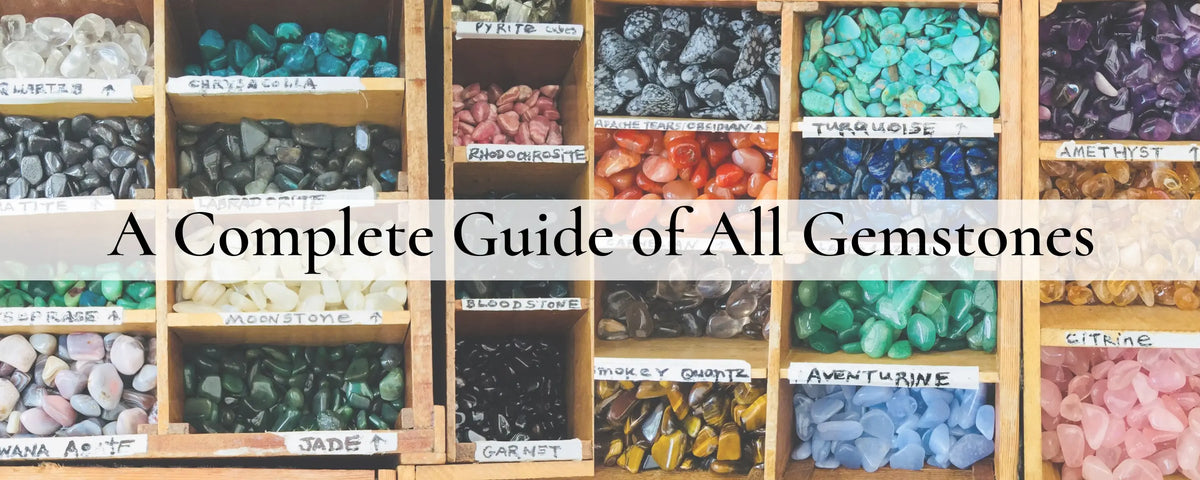History of Gemstones
The History of gemstones has spanned thousands of years, with the first humans using stones like amber and quartz for decoration and ritual purposes in prehistoric times. Ancient civilizations such as Mesopotamia, Egypt, and the Indus Valley highly valued gemstones like lapis lazuli, turquoise, and carnelian, incorporating them into jewelry and religious artifacts.
During the middle Ages, gemstones were predominantly used in religious and royal artifacts. The Renaissance revived classical knowledge of gemstones, and the Enlightenment brought scientific methods to their identification and classification.
The gemstone market has undergone a transformation in the modern era due to advances in geology and mineralogy, along with the discovery of new gemstone sources. The beauty of gemstones has led to their continued use in industrial applications, as well as their cultural and historical significance.
◼ The Color of Gemstones
The color of gemstones is a result of their chemical creation and the presence of trace elements or contaminants. All the colors of the rainbow are naturally present in gemstones, such as colorless, white, and black, as well as all shades of blue, green, red, purple, yellow and pink in between.
◼ The Shape of Gemstones
Gemstone shapes are designed to enhance the stone's natural beauty, brilliance, and color. Such as,
Round Shape
This shape is a classic and popular choice, known for its ability to enhance brilliance and sparkle.
Oval Shape
An elongated round shape that offers a larger appearance and enhanced brilliance.
Cushion Shape
Its vintage appeal and excellent light dispersion are attributed to the square or rectangular shape with rounded corners and large facets.
Heart Shape
A romantic and symbolic shape resembling a heart, ideal for sentimental jewelry pieces.
Princess Shape
A square shape with sharp corners, offering a modern and elegant look.
Marquise
An elongated shape with pointed ends, creating the illusion of a larger stone.
Emerald
A rectangular shape with step-cut facets, emphasizing clarity and color.
Radiant Shape
A rectangular shape combining the brilliance of a round cut with the elegance of an emerald cut, featuring trimmed corners.
Pear Shape
A teardrop shape that combines the round and marquise cuts, offering a unique and elegant silhouette.
Asscher Shape
A square shape with step-cut facets and a high crown, known for its art-deco style and brilliance.
Each shape highlights different aspects of the gemstone, and can be chosen based on personal preference and the intended design of the jewelry.
◼ Various Types of Gemstones
💠Precious Gemstones
Diamond

Diamonds are among the most coveted and renowned gemstones in the world, known for their brilliance, durability, and symbolic significance. Diamond is the hardest natural material on Earth, scoring a perfect 10 on the Mohs scale of mineral hardness and exhibit exceptional brilliance due to their high refractive index, which causes light to reflect within the stone.
Diamonds are most commonly used in engagement rings, wedding bands, earrings, necklaces, and bracelets, symbolizing eternal love and luxury. Typically also found in various colors such as yellow, blue, pink, and even rare red diamonds. Diamonds symbolize love, commitment, strength, and wealth in many cultures worldwide. They are often associated with special occasions and milestones, such as engagements and anniversaries. Diamond is the correct gemstone for the month of April.
Sapphire

Sapphire is a prized gemstone known for its brilliant colors, most famously deep blue, but also found in pink, yellow, green, and other hues. Sapphire is a variety of the mineral corundum, which is the second hardest natural mineral after diamond, ranking 9 on the Mohs scale of hardness.
Sapphires are cut into various shapes, such as oval, round, and emerald cuts, to maximize their beauty and color. Blue sapphire is particularly popular for wedding rings, symbolizing loyalty and has symbolized wisdom, virtue, good fortune, and protection throughout history. Sapphire is the correct gemstone for the month of September.
Ruby

Ruby is a precious gemstone prized for its rich red color and exceptional hardness. Rubies are known for their vivid red color, ranging from deep crimson to lighter shades with hints of pink. Ancient Civilizations valued rubies for their rarity and beauty. They were often included in royal regalia and believed to offer protection and strength to warriors in battle.
They are celebrated for their brilliance and symbolic associations with passion, love, and vitality, making them a popular choice in fine jewelry, especially in engagement rings and other special occasion pieces. We are Best in Making a cherished and timeless gemstone in the world of jewelry and beyond. Ruby is the perfect gemstone for the month of July.
Emerald

Emerald is a prized gemstone known for its lush green color and historical significance, ranging from light to deep, vivid shades. Emeralds belong to the beryl family and rank 7.5 to 8 on the Mohs scale of hardness, making them relatively durable. In common practice, emeralds are cut in a rectangular step-cut style, which is also known as the emerald cut.
Emeralds symbolize rebirth, fertility, and love. They are believed to bring prosperity and spiritual growth. In some traditions, emeralds are thought to have healing powers, particularly in promoting eye health and enhancing mental clarity. Emerald is the correct gemstone for the month of May.
💠Semi-Precious Gemstones
Topaz

Topaz is a silicate mineral that is highly valued as a gemstone due to its wide range of colors, brilliance, and durability. Blue topaz is a popular gemstone that ranges from pale sky blue to deep London blue and can be found in granite and rhyolite. It can also be found in alluvial deposits, where it has been weathered out of the parent rock. Its broad color range and relative affordability make it a popular choice for a variety of jewelry designs. For example, most blue topaz on the market has been irradiated and heat-treated to achieve its color.
Garnet

Garnets have been used since ancient times in various cultures for jewelry and as talismans. They were particularly popular in Ancient Egypt, Ancient Rome, and during the middle Ages. Garnet's wide range of colors, historical significance, and symbolic meanings make it a cherished and versatile gemstone for both decorative and practical uses. Garnet is a group of silicate minerals that are highly valued as gemstones for their variety of colors, excellent hardness, and rich history. Garnets come in a wide range of colors, including red, green, orange, yellow, purple, brown, and even colorless.
The most common color is a deep red. Garnets typically have good clarity and can range from transparent to opaque, with some varieties displaying unique inclusions or patterns. Its form under high temperature and pressure conditions, commonly found in metamorphic rocks such as schist and gneiss, as well as in igneous rocks and certain sedimentary deposits. Their variety of colors and affordability make them popular in both contemporary and vintage jewelry. Garnet is the birthstone for January.
Pearl

Pearls are natural gemstones that are created in the shells of certain mollusks, including oysters and mussels. Pearls come in various colors, including white, cream, pink, silver, black, and gold. The color can be influenced by the type of mollusk and the water in which it lives. Pearls are known for their beautiful luster, which is the result of light reflecting off the layers of nacre (mother-of-pearl) that make up the pearl.
Perfectly round pearls are the most valued and sought after. Larger pearls with a satin luster, often found in white, silver, & gold hues. Necklaces, earrings, rings, and bracelets are all types of jewelry that use pearls. They are also used in brooches and as embellishments on clothing and accessories.
Aquamarine

Aquamarine is a semi-precious gemstone known for its stunning blue to blue-green color, reminiscent of the sea. The beryl family includes it and it has a hardness range of 7.5 to 8 on the Mohs scale, allowing it to be used in a variety of jewelry types. Aquamarine typically has good clarity and transparency. It is often used in rings, necklaces, earrings, and bracelets and is the birthstone for March. Aquamarine symbolizes calmness, clarity, and tranquility. Regular cleaning with mild soap and water helps maintain its beauty.
Opal

Opal is a unique and mesmerizing gemstone prized for its iridescent play-of-color, which displays a spectrum of colors when viewed from different angles. Silica-rich water seeping into cracks and voids in rock cause opals to form by solidifying over time. Australia is a major source of precious opals, including the renowned Lightning Ridge and Coober Pedy mines. Opal symbolizes creativity, spontaneity, and inspiration. It is the birthstone for October.
Onyx

Onyx is a sleek and elegant gemstone known for its smooth, glossy appearance and typically deep black color, but it can also be found in other colors such as white, gray, brown, and even green. A smooth and uniform texture is achieved through a glossy finish, often polished to a high sheen. Onyx forms in the cavities of volcanic rock, where silica-rich solutions deposit layer upon layer of microcrystalline quartz. This results in its distinctive banding or parallel-layered appearance. Onyx is believed to have protective properties, shielding its wearer from negativity and harm.
Moonstone

Moonstone is a mystical gemstone known for its shimmering adularescence, a soft glow that moves across its surface like moonlight on water. Typically translucent and milky-white, moonstone can also appear in shades of peach, gray, and blue. It is a variety of feldspar, forming in pegmatite rocks. Moonstone is prized in jewelry for its ethereal beauty and is believed to symbolize intuition, femininity, and new beginnings.
Amethyst

Amethyst is a stunning semi-precious gemstone prized for its vibrant purple hue and crystalline beauty. Amethyst ranges from light lavender to deep purple, with shades influenced by its iron impurities and exposure to natural radiation. Amethyst is a type of quartz that forms in geodes within volcanic rocks. Its purple color comes from irradiation and trace amounts of iron in its crystal structure. Major deposits of amethyst are found in Brazil, Uruguay, Zambia, and Russia, among other countries. Popular in rings, necklaces, and earrings, amethyst symbolizes spirituality and inner peace, serving as the birthstone for February.
Citrine

Citrine is a beautiful gemstone known for its warm, sunny yellow to golden-orange hues. Its color is due to trace amounts of iron within the quartz crystal structure and Major deposits of citrine are found in Brazil, Bolivia, Uruguay, and Madagascar. Citrine’s cheerful color and affordability make it a favored gemstone for those seeking a bright and lively addition to their jewelry collection.
Tourmaline

Tourmaline is a fascinating gemstone known for its vibrant range of colors and unique properties. Tourmaline comes in a variety of colors, including pink, green, blue, yellow, red, and bi-color or multi-color combinations. Certain varieties like watermelon tourmaline display pink centers surrounded by green edges. unusually vibrant blue to green tourmaline from Brazil, known for its intense color and rarity. Tourmaline is found in various regions worldwide, including Brazil, Afghanistan, Mozambique, Nigeria, and the United States. Some believe tourmaline has metaphysical properties, including promoting inspiration, creativity, and balancing energies.
💠Cubic Zirconia
The synthetic gemstone Cubic Zirconia (CZ) is well-known for its diamond-like shine and affordability. it is optically flawless and colorless, often cut and polished to mimic the brilliance and fire of diamonds. This Gemstone is made from zirconium dioxide, synthesized to create gem-quality crystals through a process involving high heat and pressure. Cubic Zirconia (CZ) is much more affordable than diamonds, making it a popular alternative in jewelry. Cubic Zirconia's affordability and diamond-like appearance make it a popular choice for those seeking elegant jewelry without the high cost of diamonds.
◼ Seven Essential Characteristics of Gemstones
1️⃣ Color
The cut of a gemstone is the result of its shape and faceting, which influence the way light interacts with the stone. Gemstone colors range from transparent to opaque and spans a spectrum of hues, influencing its visual appeal and rarity. It can include hues like blue, red, green, yellow, pink, and other.
2️⃣ Clarity
Clarity refers to the absence or presence of internal flaws and external blemishes. Stones with minimal inclusions are considered more valuable due to their enhanced transparency and brilliance.
3️⃣ Cut
The shape and faceting of a gemstone's cut have an impact on how light interacts with it. A well-cut gemstone reflects light effectively, maximizing its brilliance and sparkle.
4️⃣ Carat
Carat weight measures the size of the gemstone. Larger gemstones of high quality are rarer and more valuable, though smaller stones of exceptional quality can also be highly prized.
5️⃣ Hardness
A gemstone is resistance to scratching and abrasion is indicated by its hardness, which is measured on the Mohs scale. Suitable for everyday wear, harder gemstones are more durable.
6️⃣ Luster
The gemstone's surface reflects light in a way that is described as luster. It can range from adamantine (diamond-like brilliance) to silky or greasy (as seen in certain minerals like jade).
7️⃣ Rarity and Origin
The origin of a gemstone, along with its rarity, can significantly influence its value. Gemstones produced in certain regions are known for their exceptional quality and unique characteristics.
◼ Natural or Synthetic Gemstones
The main differences between natural and synthetic gemstones lie in their origin, formation process, and their value and characteristics. Natural gemstones form naturally within the Earth's crust over millions of years through geological processes. They are composed of minerals and elements naturally occurring in the Earth. Natural gemstones are generally more valuable and sought after due to their rarity, natural beauty, and sometimes historical.
Synthetic gemstones are created in laboratories using controlled processes to mimic the natural conditions under which gemstones form. They are made from materials that replicate the chemical and physical properties of natural gemstones, such as minerals, oxides, and other compounds. Synthetic gemstones can be nearly identical to natural ones in terms of appearance, hardness, and optical properties. Both types are widely used in jewelry, each appealing to different preferences and considerations in terms of origin, ethics, and desired characteristics.
Conclusion
Gemstones often undergo treatments and enhancements to improve their appearance, durability, or color consistency. Heat treatment is commonly used to change color, irradiation is used to enhance color, and filling is used to improve clarity. These treatments are widely used in the industry to enhance gemstone beauty and consistency but should be disclosed to ensure transparency in the market. Each treatment method serves specific purposes, aiming to optimize gemstone quality and appeal for jewelry and other uses.
Browse our Store and you can buy the beautiful Gemstones from Glazed Diamonds.




